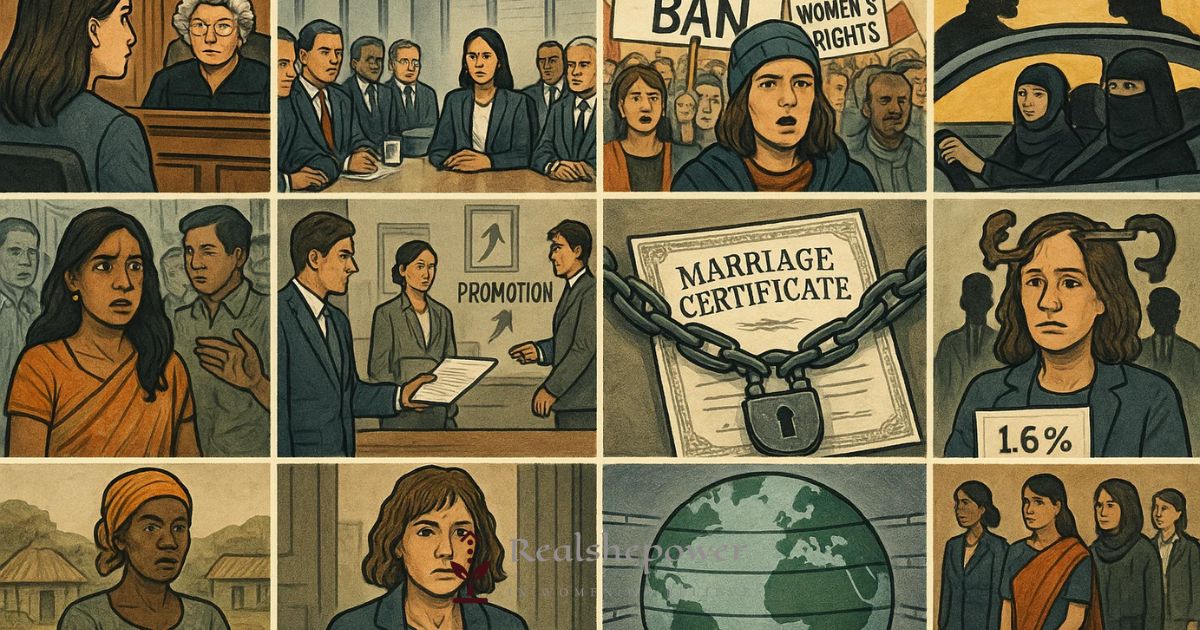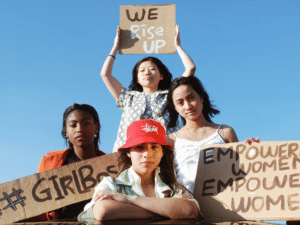For centuries, laws have been written in the language of fairness while quietly serving the interests of those already in power. In theory, laws are supposed to protect the vulnerable. In reality, many laws concerning women are designed less to protect them and more to protect the social order that keeps men in control.
This is not just a historical problem. Even today, in democracies that pride themselves on equality, women are often told, “You have rights now, what more do you want?” The truth is that the existence of a law does not guarantee the justice it promises. In fact, many of these laws operate like smoke screens, creating the illusion of safety and fairness while ensuring that the foundations of patriarchy remain untouched.
The Language of Protection vs. The Reality of Control
A common trick in lawmaking is framing control as protection. Historically, laws regulating women’s bodies, movement, and participation in public life were presented as being for their own safety. In the 19th century, women were barred from working in certain “dangerous” jobs or working night shifts because the law claimed it was safeguarding their health. In reality, these rules kept them out of higher-paying industrial roles and restricted them to low-wage “acceptable” jobs like domestic service or textile work.
Even in modern contexts, laws about women’s dress codes, curfews, or access to certain spaces are often justified as protective measures. The underlying assumption is that the world is inherently dangerous for women, so instead of addressing male violence, the law focuses on controlling women’s behavior. It shifts responsibility from the perpetrator to the potential victim.
Case Study 1: Guardianship Laws in Saudi Arabia – A System of Adult Custodianship
While Saudi Arabia lifted its infamous driving ban for women in 2018, the male guardianship system still gives male relatives the legal authority to make critical decisions for women. This includes travel, marriage, and in some cases, access to healthcare. The reform was celebrated internationally as a huge leap forward, but the core legal structure that treats women as perpetual minors remains in place. In practice, this means a woman can drive a car but still cannot leave the country or marry without permission from her male guardian.
The “protection” rationale here is clear — women are framed as needing oversight for their own safety, while the true effect is control over their autonomy.
Case Study 2: Afghanistan’s “Protective” Restrictions on Women Post-2021
Since the Taliban’s return to power, they have framed many of their policies toward women as “protection of honor” or “preservation of virtue.” In practice, these restrictions ban girls from secondary education, prevent women from traveling without a male chaperone, and severely limit their employment. The justification is always framed as moral safeguarding, but the result is systemic erasure of women from public life. The laws and decrees do not simply restrict; they remove women’s ability to function as independent members of society.
The Illusion of Progress in Workplace Laws
Workplace equality laws are often cited as proof that gender discrimination is over. Yet loopholes and weak enforcement allow discrimination to flourish. For example, the United States’ Equal Pay Act of 1963 made it illegal to pay women less than men for the same work. But decades later, the gender pay gap persists in every industry. Why? Because companies use vague job classifications to justify paying women less or hide behind confidentiality clauses that make it impossible for employees to compare salaries.
Maternity leave laws also reveal this dynamic. While many countries mandate paid leave, the same laws often fail to protect women from retaliation. Employers may quietly sideline mothers, denying them promotions or steering them toward less influential roles. The law technically allows them to return to work, but does not require that they return to the same opportunities they had before.
Case Study 3: The Equal Pay Act in the United States – Legal Yet Ineffective
The Equal Pay Act of 1963 was intended to eliminate wage disparity based on gender. Yet sixty years later, women still earn significantly less than men in almost every industry. Employers often exploit vague job descriptions to justify pay differences, classifying roles in ways that mask unequal pay for equal work. Salary confidentiality policies make it difficult for employees to discover discrepancies, meaning the law’s promise of equality is undermined by the way it is applied — or rather, not applied. The law exists on paper, but its lack of enforceability allows inequality to thrive in plain sight.
Case Study 4: Pregnancy Discrimination in the Workplace – Legal Protections Without Real Power
In the U.S., the Pregnancy Discrimination Act of 1978 made it illegal to fire or demote someone for being pregnant. However, countless women report being quietly pushed out, denied promotions, or reassigned to lower-impact roles after returning from maternity leave. While retaliation is technically illegal, proving it is extremely difficult. In one high-profile case, a Wall Street banker returned from maternity leave to find her accounts reassigned to male colleagues, effectively ending her career trajectory. She sued, but the case dragged on for years and settled quietly.
The law exists, but the social and institutional willingness to sideline mothers persists — proving that paper protections do not guarantee real-world equality.
Case Study 5: Japan’s Gender Equality Employment Law – Progress That Stalled
Japan passed the Equal Employment Opportunity Law in 1985, aiming to prevent gender discrimination in hiring and promotion. However, it carries no real penalties for companies that ignore it. As a result, women remain severely underrepresented in leadership roles. Employers often funnel women into career tracks with limited advancement opportunities, using cultural norms as justification. The law exists as a symbolic gesture rather than a transformative force.
When Laws Criminalize but Fail to Protect
Sexual harassment and assault laws exist in most countries, but the conviction rates tell a very different story. In the UK, only around 1.6% of reported rapes result in a charge. In India, despite strict laws on paper, survivors often face brutal cross-examination and social stigma that deter others from coming forward. The problem is not just enforcement. It is the way the legal process itself is structured to discredit women’s testimony and prioritize the accused’s rights over the victim’s safety.
Some countries still require proof of “sufficient resistance” in sexual assault cases, implying that unless a woman is physically injured, she must have consented. Others, like parts of the United States until recently, allowed the “marital rape exemption,” which stated that a husband could not be charged with raping his wife. Even when removed from the books, such laws leave behind decades of legal precedent that shape court decisions today.
Case Study 6: Marital Rape Laws in the United States – The Loophole That Writes Abuse Into Marriage
While most Americans assume marital rape is illegal everywhere, loopholes still exist in multiple U.S. states. Some states have exemptions if the victim is incapacitated, unconscious, or otherwise unable to consent, but only if the perpetrator is a stranger. If the perpetrator is a spouse, those protections may not apply.
In 2022, Minnesota finally repealed a law that prevented prosecution of rape if the victim was the spouse of the accused. For decades, survivors were told their assault “wasn’t rape” because of a marriage license. This shows how the law can openly prioritize the institution of marriage over the bodily autonomy of women inside it.
Case Study 7: Rape Law in India – Justice on Paper, Trauma in Practice
India’s 2013 Criminal Law Amendment Act strengthened rape laws after the Delhi gang rape case, introducing stricter sentences and expanding the definition of sexual assault. Yet conviction rates remain low, and survivors still face humiliating cross-examination in court. In many rural areas, police refuse to register cases, or families are pressured into informal settlements with perpetrators. The law’s existence has not dismantled the societal structures — from victim-blaming to institutional apathy — that make justice nearly unreachable for many women.
Case Study 8: The United Kingdom’s Sexual Offences Act – A Law That Doesn’t Deliver Justice
The UK’s Sexual Offences Act of 2003 modernized the definition of consent and strengthened penalties for sexual assault. Yet conviction rates for rape have plummeted to historic lows, with only a small fraction of reported cases ever reaching court. Survivors often describe the process as more traumatizing than the assault itself, facing invasive questioning, long delays, and in some cases, having their personal sexual history used against them. The law is progressive in wording, but in practice, systemic disbelief of women undermines its power.
Laws That Protect the Patriarchy by Controlling Reproductive Rights
Control over reproduction has always been central to maintaining patriarchal power. When the state controls when and how women can have children, it controls their economic, social, and political participation. Anti-abortion laws are often justified as “protecting life,” but they also ensure that women remain tied to caregiving roles, reducing their mobility and independence.
Even in countries where abortion is legal, restrictive regulations, mandatory waiting periods, and limited clinic access make it practically unavailable for many women. Similarly, laws around contraception access or sterilization often come with hidden biases, allowing providers to deny services based on personal beliefs or marital status.
Case Study 9: Roe v. Wade Overturned – The U.S. Pushes Women Backward
In 2022, the U.S. Supreme Court overturned Roe v. Wade, ending the federal right to abortion and allowing individual states to impose severe restrictions or outright bans. Many states immediately enacted “trigger laws” banning abortion even in cases of rape or incest. These laws claim to protect life, yet they disregard the health, autonomy, and lived realities of women. The decision disproportionately affects low-income women and women of color, who have fewer resources to travel to states where abortion remains legal.
Case Study 10: Poland’s Abortion Ban – A Law That Costs Lives
Poland has one of the strictest abortion laws in Europe, allowing the procedure only in cases of rape, incest, or when the mother’s life is at risk. Even in life-threatening cases, doctors often delay intervention out of fear of legal consequences. In 2021, a pregnant woman died after doctors refused to perform an abortion despite clear signs of sepsis. The government defended the law as “protecting the unborn,” but in practice, it endangered and ended the life of the woman carrying the pregnancy.
Case Study 11: Nicaragua’s Total Abortion Ban – Criminalizing Survival
Nicaragua criminalized abortion entirely in 2006, with no exceptions for rape, incest, or danger to the mother’s life. Women and girls, including rape survivors, have been forced to carry pregnancies to term under threat of imprisonment. Doctors face prison sentences for performing abortions, even in medical emergencies. The law is framed as a moral necessity, but in reality, it is a legal mechanism for enforcing patriarchal control over women’s bodies.
Alright — here’s the concluding section that ties together all 10 case studies and gives you space for internal linking to your original piece.
Conclusion: The Law’s Mask of Equality
Across cultures, legal systems claim to protect women but often work to maintain the very hierarchies that harm them. From Saudi Arabia’s guardianship rules to Poland’s abortion ban, from U.S. marital rape loopholes to Japan’s unenforced workplace equality law, the pattern is the same:
laws give the appearance of progress while preserving the foundations of male dominance.
These ten case studies show how this plays out in four major arenas:
- Control disguised as protection — where women are treated as perpetual dependents.
- Symbolic workplace equality — where anti-discrimination laws lack enforcement.
- Criminalization without protection — where assault laws exist but are undermined by disbelief and stigma.
- Reproductive control — where the state dictates the conditions of women’s bodily autonomy.
In each case, the wording of the law may sound progressive or protective, but the power dynamics beneath it tell another story. Laws are not neutral; they are tools shaped by the societies that create them. If the society is patriarchal, then the law — no matter how “equal” it sounds — will be built to protect patriarchy first.
Real change will not come from adding new laws alone. It will require dismantling the legal, political, and cultural systems that normalize inequality under the guise of protection. Until then, women will keep living under a legal order that talks about safeguarding them while safeguarding the power of those above them.








































